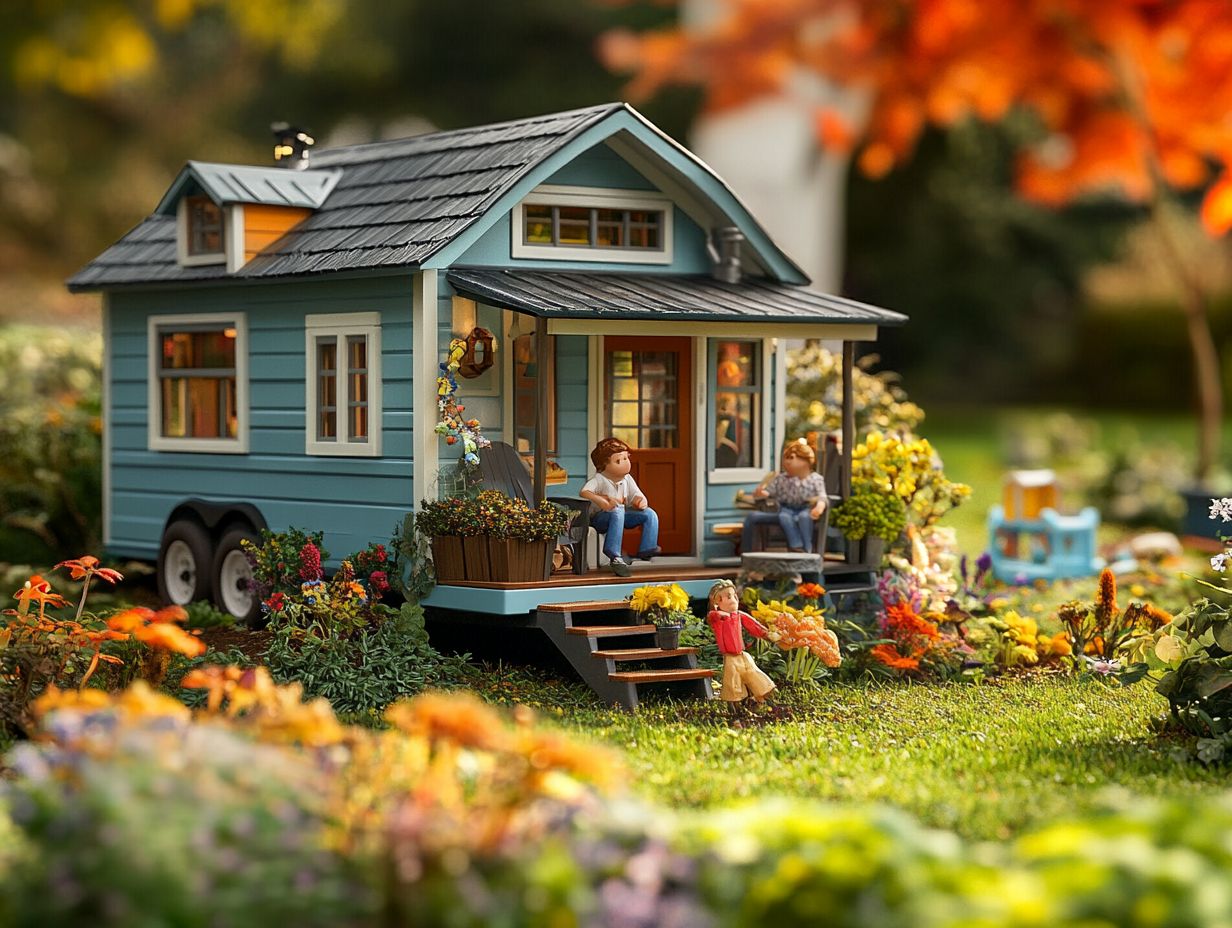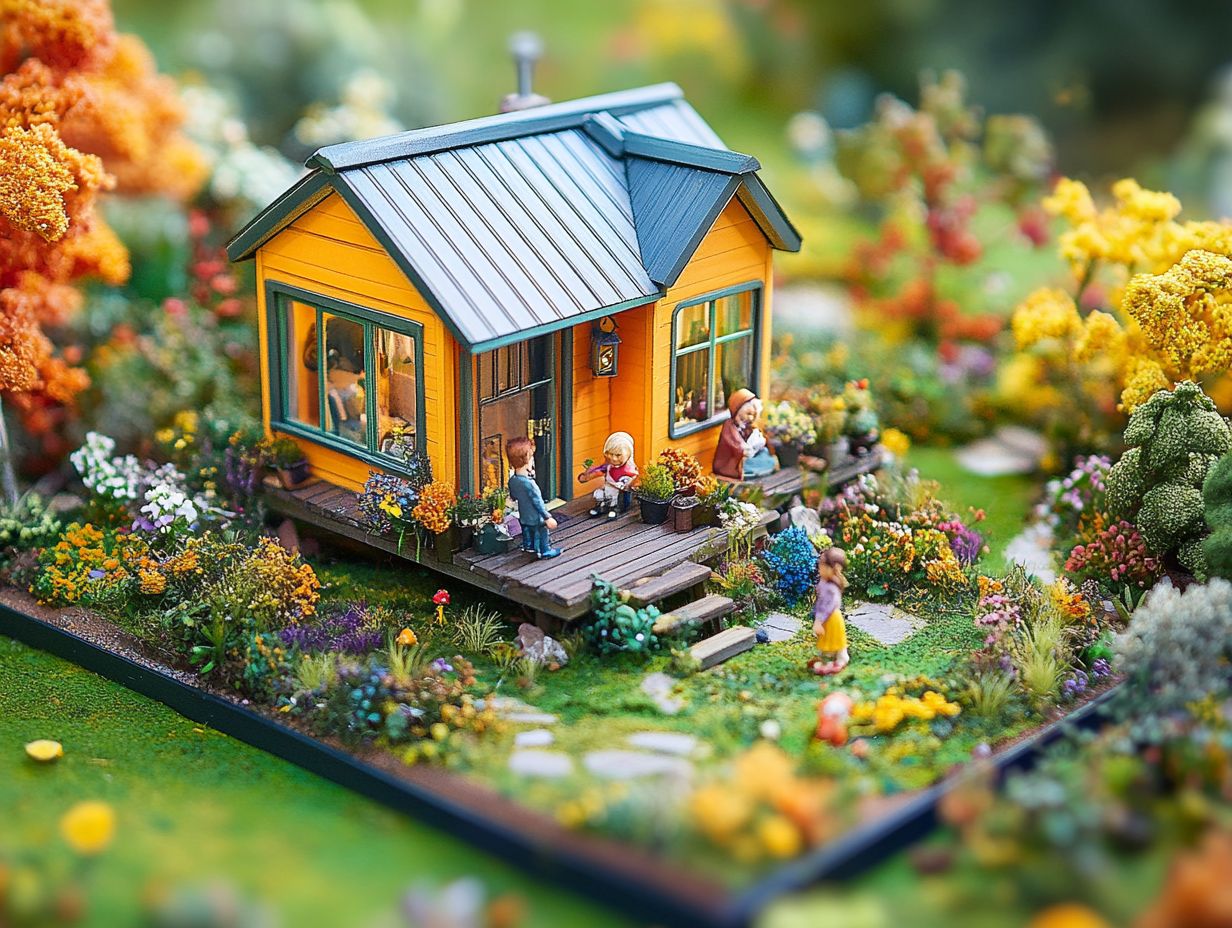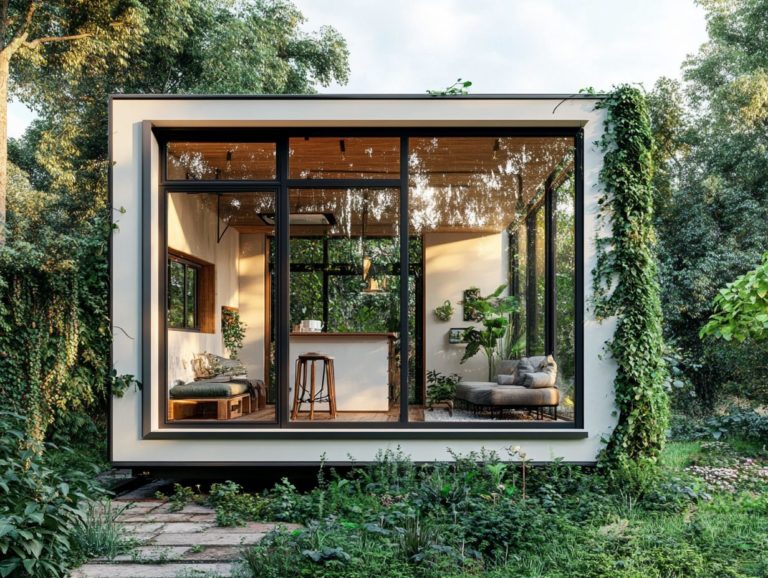Can I Live in a Tiny House with a Family?
Thinking about a tiny house for your family? You re in good company! Tiny living has emerged as a compelling lifestyle choice, offering the allure of financial freedom and a more streamlined way of life.
So, what exactly qualifies as a tiny house? While the benefits are certainly appealing, it’s important to consider the challenges that may arise, particularly regarding space and privacy in a family environment.
This article delves into the intricacies of tiny house living, providing tips on how to maximize your space and exploring alternative options if you find you need a bit more room.
Jump in and discover how tiny living might just be the perfect adventure for your family!
Contents
- Key Takeaways:
- Understanding Tiny Houses
- Benefits of Living in a Tiny House
- Challenges of Living in a Tiny House with a Family
- Tips for Making it Work
- Alternative Living Options for Families
- Frequently Asked Questions
- Can I Live in a Tiny House with a Family?
- What is considered a tiny house?
- How many people can comfortably live in a tiny house?
- What are the challenges of living in a tiny house with a family?
- Are there any benefits to living in a tiny house with a family?
- Do I need special permits or zoning to live in a tiny house with a family?
Key Takeaways:

- Living in a tiny house with a family offers financial and lifestyle benefits like lower expenses.
- Challenges around space and privacy can be managed with good communication.
- Alternative small living options, such as RVs or co-housing, may be viable for some families.
Understanding Tiny Houses
Understanding tiny houses means recognizing their distinct traits, which embrace a minimalist lifestyle and promote eco-friendly living. These compact homes, usually under 400 square feet, are crafted to maximize functionality while encouraging family connections through shared activities and communal spaces.
They often feature innovative storage solutions, highlighting the value of quality time together, the pleasures of outdoor living, and a deeper connection to nature. Many families choose tiny houses because they provide the freedom of living without a home loan, accommodating flexible work arrangements and family dynamics. For those interested in this lifestyle, designing a tiny house for family living can ultimately enrich their shared experiences.
What Constitutes a Tiny House?
A tiny house is defined by its compact size, typically under 400 square feet, featuring smart design customizations that optimize every inch of space.
These charming little abodes have gained traction as many families embrace the idea of downsizing and simplifying their living situations. The core components of a tiny house often include a carefully designed floor plan that meets local zoning and building regulations.
Innovative design elements, like furniture that does more than one thing—think foldable tables or beds that fold up to save space—are essential for maximizing the limited square footage. For families, how to build a tiny house with kids involves the concept of dual-purpose spaces, enabling a single area to serve multiple functions, such as a living room that effortlessly transforms into a guest bedroom.
This flexibility not only elevates functionality but also fosters a more sustainable lifestyle, making creating a family-friendly tiny house a smart choice for the modern dweller.
Benefits of Living in a Tiny House
Embracing life in a tiny house offers a wealth of advantages, especially when it comes to achieving financial freedom. Imagine enjoying life without a mortgage. How would that change your family experiences? By stepping into this lifestyle, you can relish a mortgage-free existence, allowing you to redirect your resources toward enriching family experiences and quality time, rather than being tied down by monthly payments.
Financial and Lifestyle Advantages

The financial and lifestyle advantages of living in a tiny house are truly remarkable. By opting for a mortgage-free arrangement, you can save a significant amount of money while embracing a simplified lifestyle that seamlessly accommodates your travel aspirations.
With living expenses dramatically reduced, you can redirect those resources toward experiences that foster personal growth and community engagement. This transition from material possessions to prioritizing life experiences not only enhances your well-being but also nurtures deeper connections within your community.
The flexibility of tiny house living allows you to relocate effortlessly, opening doors to new places and diverse encounters. For those looking to maximize their space, learning how to design a tiny house for family living can be invaluable. Ultimately, this lifestyle fosters a harmonious balance between financial stability and enriching experiences, leading to increased savings and a profound appreciation for what truly matters in life.
Challenges of Living in a Tiny House with a Family
Living in a tiny house can indeed be a rewarding experience. However, families frequently encounter challenges stemming from limited space. This situation demands exceptional organizational skills and creative solutions to ensure that each family member enjoys their personal space and privacy.
Space and Privacy Considerations
In tiny houses, space and privacy are essential for nurturing healthy family dynamics. The limited square footage can often result in a struggle for personal space among family members.
To navigate these challenges effectively, implement design solutions that maximize utility while fostering a sense of connection. Don t wait! Embrace furniture that serves more than one purpose, such as sofas that convert into beds or tables that fold away, to create more versatile spaces.
Incorporating designated zones within your home, like a cozy reading nook or a compact workspace, can enhance privacy and assist in managing individual pursuits.
You can also use visual dividers, like curtains or bookshelves, to help establish boundaries while still encouraging closeness and interaction. By thoughtfully arranging your tiny living environment, you can cultivate emotional intimacy without sacrificing the necessary personal space everyone needs. It’s also important to consider the legal considerations for families when living in a tiny house.
Tips for Making it Work
To thrive in a tiny house, adopt various strategies that elevate your organization skills and create multifunctional spaces. This approach not only fosters family togetherness but also helps you establish a structured cleaning routine, ensuring that your living environment remains orderly and inviting.
Maximizing Space and Organization

Maximizing space and organization in your tiny house requires creative thinking and clever storage solutions that adapt to your evolving needs.
To achieve this, consider utilizing vertical storage options like wall-mounted shelves and hanging organizers. These can dramatically increase your usable space while ensuring that everything remains easily accessible.
Additionally, incorporating furniture that serves more than one purpose, such as a sofa bed or a coffee table with hidden compartments, enhances versatility without compromising on style.
You can also employ design tricks like choosing lighter colors and strategically placing mirrors to create an illusion of spaciousness, making your area feel more open and inviting.
With these thoughtful adjustments, even the coziest living spaces can remain functional, stylish, and perfectly aligned with your lifestyle.
Communication and Compromise
Effective communication and compromise are essential for navigating family dynamics in a tiny house, where close quarters can amplify emotions and demand a culture of understanding and cooperation.
In these compact living spaces, you’ll find yourself maneuvering through shared responsibilities and personal boundaries. Fostering open dialogues is crucial as it allows each family member to express their feelings and needs without the fear of being judged.
Establishing regular family meetings or check-ins can be a game-changer, giving everyone a platform to voice their concerns and aspirations, thus cultivating a sense of unity.
Engaging in shared activities, like family game nights or cooking together, can further deepen emotional connections and fortify bonds.
Ultimately, when family members prioritize understanding and embrace the art of compromise, they craft a nurturing environment that fosters happiness and resilience.
Alternative Living Options for Families
For families in search of alternative living arrangements, exploring diverse small living options can unlock a world of thrilling travel adventures, foster meaningful community connections, and provide the flexibility to pursue jobs that harmonize with a more streamlined lifestyle.
Exploring Other Small Living Options
Exploring alternative small living options opens up unique opportunities for your family, paving the way for travel adventures and a lifestyle that champions eco-friendly practices and community engagement.
Imagine the charm of micro-apartments. These stylishly designed units transform minimal square footage into compact, functional living spaces. Nestled in urban areas, they grant you easy access to amenities and cultural attractions that enrich daily life. If you’re considering a more minimalist lifestyle, you might wonder, is it possible to downsize to a tiny house?
Mobile homes offer an enticing option as well. They provide your household with the flexibility to relocate while maintaining a sense of ownership. While both choices have challenges like limited space and potential zoning rules, they inspire families to embrace simplicity. If you’re curious about whether tiny house living is suitable for families, it can also help you make the most of your resources.
By adapting to these small living environments, you can cultivate stronger connections with your neighbors. For families with kids, exploring tiny house design ideas can further enhance this vibrant, close-knit community atmosphere that enriches your family’s experience.
Frequently Asked Questions

-
Can I Live in a Tiny House with a Family?
Yes, it is possible to live in a tiny house with a family. However, it may require some adjustments and careful planning.
-
What is considered a tiny house?
A tiny house is typically defined as a dwelling that is under 400 square feet in size. It can be on wheels or a foundation.
-
How many people can comfortably live in a tiny house?
This depends on the layout and design of the tiny house. Some can comfortably accommodate a family of four, while others may only be suitable for a couple or a small family.
-
What are the challenges of living in a tiny house with a family?
One of the main challenges is the lack of space, which may require creative storage solutions and a minimalist lifestyle. Communication and privacy can also be potential challenges.
-
Are there any benefits to living in a tiny house with a family?
Living in a tiny house brings your family closer together, creating lasting bonds. It also allows for a more affordable and environmentally friendly lifestyle.
-
Do I need special permits or zoning to live in a tiny house with a family?
The regulations for tiny house living vary by location. Some places may require special permits or have specific zoning laws, so it’s important to research and comply with local regulations.
Embrace the joy of tiny living and explore how it can transform your family’s lifestyle while fostering a sense of community!






